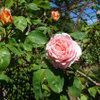Roll Call of the Intrepid
ingrid_vc so. CA zone 9
10 years ago
Related Stories

KITCHEN DESIGNShow Us Your Fabulous DIY Kitchen
Did you do a great job when you did it yourself? We want to see and hear about it
Full Story
COFFEE WITH AN ARCHITECTAn Architect's Calling Cards: Part 2
In the battle against social awkwardness, an intrepid architect calls upon ... what else? His design skills
Full Story
LIFEYou Said It: ‘We Call It Character’
Design advice, inspiration and observations that struck a chord this week on Houzz
Full Story
PETSHouzz Call: Looking for Dogs in Design
Share a Pic of Your Pet, and He or She Could Star on Our Homepage
Full Story
Houzz Call: Show Us Your Paint Makeovers
Let your newly repainted house or room do the "How d'ya like me now?" strut right here — it might just be featured in an upcoming ideabook
Full Story
GARDENING GUIDESWhat Are Your Spring Gardening Plans?
Tearing out the lawn? Planting edibles? Starting from scratch? Tell us what you plan to change in your garden this year
Full Story
FUN HOUZZDream Spaces: Midcentury Bowling Lanes Roll On in Minnesota
This luxury home bowling alley made with vintage parts may just knock your socks off
Full Story
SMALL HOMESHouzz Tour: Rolling With Simplicity in a Tiny House on Wheels
Just 240 square feet, this California home encourages efficient living — but there’s still room for yoga
Full Story
HOUZZ TOURSHouzz Call: Show Us Your Industrial Loft!
Bring on the brick and metal. If you live in a converted warehouse or an edgy loft, we’d love to see it
Full Story
DIY PROJECTSMake a Cute and Low-Cost Rolling Table
Turn a free salvage spool into a chic outdoor party table with an easy-to-make slipcover and wheels
Full StoryMore Discussions








roseseek
strawchicago z5
Related Professionals
Simpsonville Landscape Architects & Landscape Designers · Fitchburg Landscape Architects & Landscape Designers · Suffern Landscape Architects & Landscape Designers · Jackson Landscape Contractors · Milford Landscape Contractors · Camp Verde Landscape Contractors · Columbine Landscape Contractors · Framingham Landscape Contractors · Setauket-East Setauket Landscape Contractors · Shoreview Landscape Contractors · West Allis Landscape Contractors · West Orange Landscape Contractors · Chicago Ridge Landscape Contractors · Annapolis Siding & Exteriors · Plano Siding & Exteriorsroseseek
Kippy
roseseek
Kippy
User
joshtx
roseseek
lori_elf z6b MD
prickles
catspa_NoCA_Z9_Sunset14
roseseek
User
catspa_NoCA_Z9_Sunset14
jaspermplants
catspa_NoCA_Z9_Sunset14
roseseek
ingrid_vc so. CA zone 9Original Author
catspa_NoCA_Z9_Sunset14
bluegirl_gw
Poorbutroserich Susan Nashville
Lynn-in-TX-Z8b- Austin Area/Hill Country
roseseek
Lynn-in-TX-Z8b- Austin Area/Hill Country
roseseek